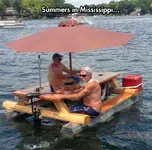Jolly Mon
Hero Member
- Joined
- Sep 3, 2012
- Messages
- 868
- Reaction score
- 631
- Golden Thread
- 0
- Primary Interest:
- All Treasure Hunting
- #1
Thread Owner
I have an old J.W. Fisher's proton 3 mag and was thinking that it might be possible to drag the fish directly beneath a small inflatable with a 9.9 hp outboard. The depth of drop for the fish would vary, but I am primarily interested in relatively small targets in shallow water, so 10 to 15 feet from the bottom of the inflatable to the fish would be ideal.
I can keep the amount of ferrous material on the inflatable to a minimum, but obviously the outboard is the big bugaboo.
Will the error introduced to the mag from the outboard remain relatively consistent during slow straight runs?
Will it greatly affect the sensitivity of the mag?
I actually got the idea from the method JW Fishers recommends for pinpointing in the Proton 3 manual.
I love the idea of being able to tow the fish directly beneath the boat for obvious reasons and was wondering if anyone has ever tried this method or anything similar.
I can keep the amount of ferrous material on the inflatable to a minimum, but obviously the outboard is the big bugaboo.
Will the error introduced to the mag from the outboard remain relatively consistent during slow straight runs?
Will it greatly affect the sensitivity of the mag?
I actually got the idea from the method JW Fishers recommends for pinpointing in the Proton 3 manual.
I love the idea of being able to tow the fish directly beneath the boat for obvious reasons and was wondering if anyone has ever tried this method or anything similar.
Last edited:






